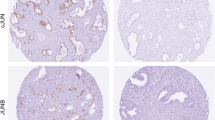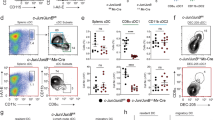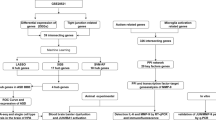Abstract
To investigate the role of individual Jun proteins in cell growth and transformation, we have used a doxycycline-inducible retroviral vector to regulate their expression in rat fibroblasts. AP-1 complexes enriched with cJun and JunB result in morphological alterations and anchorage-independent cell growth consistent with a transformation-like phenotype, whereas complexes enriched with JunD had an antiproliferative effect. These results suggest that genes regulated by both cJun and JunB are potentially involved in transformation and that they can be distinguished from those regulated by AP-1 complexes containing JunD. To identify genes regulated by cJun and JunB that may have a role in anchorage-independent growth, we investigated differential gene expression by each of the Jun family members using the Affymetrix Rat oligonucleotide microarray, RG_U34A containing approximately 8000 genes. Differentially regulated genes were identified and grouped for correlation with regulation by the different Jun proteins. A total of 33 candidate genes were found to be differentially regulated by both cJun and JunB and not by JunD. These genes have roles in cell metabolism, growth, signal transduction, migration and adhesion. We validated the differential regulation by cJun and JunB of 10 candidate genes by Northern blot analysis. Of these, eight were further characterized as potential direct targets of AP-1 regulation based on Northern blot results showing differential regulation that correlate with cJun expression. Our results show that inducible cJun and JunB expression result in anchorage-independent growth of Rat1a cells, distinct from JunD-expressing cells. This model system and a functional genomic approach enabled us to differentiate AP-1-regulated genes involved in transformation from AP-1-regulated genes known as bystander genes. This approach significantly reduces the number of bystanders and allows for the targeting of genes specifically involved in transformation.
This is a preview of subscription content, access via your institution
Access options
Subscribe to this journal
Receive 50 print issues and online access
$259.00 per year
only $5.18 per issue
Buy this article
- Purchase on SpringerLink
- Instant access to full article PDF
Prices may be subject to local taxes which are calculated during checkout









Similar content being viewed by others
Accession codes
References
Angel P, Allegretto EA, Okino ST, Hattori K, Boyle WJ, Hunter T and Karin M . (1988). Nature, 332, 166–171.
Angel P, Imagawa M, Chiu R, Stein B, Imbra RJ, Rahmsdorf HJ, Jonat C, Herrlich P and Karin M . (1987). Cell, 49, 729–739.
Briggs J, Chamboredon S, Castellazzi M, Kerry JA and Bos TJ . (2002). Oncogene, 21, 7077–7091.
Buse P, Tran SH, Luther E, Phu PT, Aponte GW and Firestone GL . (1999). J. Biol. Chem., 274, 7253–7263.
Castellazzi M, Dangy JP, Mechta F, Hirai S, Yaniv M, Samarut J, Lassailly A and Brun G . (1990). Oncogene, 5, 1541–1547.
Castellazzi M, Spyrou G, La Vista N, Dangy JP, Piu F, Yaniv M and Brun G . (1991). Proc. Natl. Acad. Sci. USA, 88, 8890–8894.
Chinenov Y and Kerppola TK . (2001). Oncogene, 20, 2438–2452.
Chiu R, Angel P and Karin M . (1989). Cell, 59, 979–986.
Cohen SB, Waha A, Gelman IH and Vogt PK . (2001). Oncogene, 20, 141–146.
Dignam JD, Lebovitz RM and Roeder RG . (1983). Nucleic Acids Res., 11, 1475–1489.
Deng T and Karin M . (1993). Genes Dev., 7, 479–490.
Engelman JA, Wykoff CC, Yasuhara S, Song KS, Okamoto T and Lisanti MP . (1997). J. Biol. Chem., 272, 16374–16381.
Fu S, Bottoli I, Goller M and Vogt PK . (1999). Proc. Natl. Acad. Sci. USA, 96, 5716–5721.
Fiucci G, Ravid D, Reich R and Liscovitch M . (2002). Oncogene, 21, 2365–2375.
Hartl M, Reiter F, Bader AG, Castellazzi M and Bister K . (2001). Proc. Natl. Acad. Sci. USA, 98, 13601–13606.
Henriet P, Zhong ZD, Brooks PC, Weinberg KI and DeClerck YA . (2000). Proc. Natl. Acad. Sci. USA, 97, 10026–10031.
Hirai S, Bourachot B and Yaniv M . (1990). Oncogene, 5, 39–46.
Ho CC, Huang PH, Huang HY, Chen YH, Yang PC and Hsu SM . (2002). Am. J. Pathol., 161, 1647–1656.
Johnson RS, van Lingen B, Papaioannou VE and Spiegelman BM . (1993). Genes Dev., 7, 1309–1317.
Kato K, Hida Y, Miyamoto M, Hashida H, Shinohara T, Itoh T, Okushiba S, Kondo S and Katoh H . (2002). Cancer, 94, 929–933.
Kerppola TK and Curran T . (1991). Cell, 66, 317–326.
Kinoshita I, Leaner V, Katabami M, Manzano RG, Dent P, Sabichi A and Birrer MJ . (2003). Oncogene, 22, 2710–2722.
Lamph WW, Wamsley P, Sassone-Corsi P and Verma IM . (1988). Nature, 334, 629–631.
Li L, Yang G, Ebara S, Satoh T, Nasu Y, Timme TL, Ren C, Wang J, Tahir SA and Thompson TC . (2001). Cancer Res., 61, 4386–4392.
Lim A, Greenspan DS and Smith BD . (1994). Matrix Biol., 14, 21–30.
Macian F, Lopez-Rodriguez C and Rao A . (2001). Oncogene, 20, 2476–2489.
Maeshima Y, Colorado PC, Torre A, Holthaus KA, Grunkemeyer JA, Ericksen MB, Hopfer H, Xiao Y, Stillman IE and Kalluri R . (2000). J. Biol. Chem., 275, 21340–21348.
Mechta F, Lallemand D, Pfarr CM and Yaniv M . (1997). Oncogene, 14, 837–847.
Mechta-Grigoriou F, Gerald D and Yaniv M . (2001). Oncogene, 20, 2378–2389.
Mellstrom B, Achaval M, Montero D, Naranjo JR and Sassone-Corsi P . (1991). Oncogene, 6, 1959–1964.
Mikosz CA, Brickley DR, Sharkey MS, Moran TW and Conzen SD . (2001). J. Biol. Chem., 276, 16649–16654.
Naranjo JR, Mellstrom B, Achaval M, Lucas JJ, Del Rio J and Sassone-Corsi P . (1991). Oncogene, 6, 223–227.
Nishitani J, Chen Z, Qin M, Liu F, Chen H, Nelson SF and Liu X . (2002). Cell. Mol. Biol. (Noisy-le-grand), 48 Online Pub, OL331–OL341.
Passegue E, Jochum W, Behrens A, Ricci R and Wagner EF . (2002). Nat. Genet., 30, 158–166.
Passegue E and Wagner EF . (2000). EMBO J., 19, 2969–2979.
Pfarr CM, Mechta F, Spyrou G, Lallemand D, Carillo S and Yaniv M . (1994). Cell, 76, 747–760.
Ryseck RP and Bravo R . (1991). Oncogene, 6, 533–542.
Sambrook J, Fritsch EF and Maniatis T . (1989). Molecular Cloning, A Laboratory, Manual, 2nd edition. Cold Spring Harbor Laboratory, Cold Spring Harbor, New York.
Schorpp-Kistner M, Wang ZQ, Angel P and Wagner EF . (1999). EMBO J., 18, 934–948.
Schutte J, Minna JD and Birrer MJ . (1989). Proc. Natl. Acad. Sci. USA, 86, 2257–2261.
Semb H and Christofori G . (1998). Am. J. Hum. Genet., 63, 1588–1593.
Shaulian E and Karin M . (2001). Oncogene, 20, 2390–2400.
Smeal T, Binetruy B, Mercola DA, Birrer M and Karin M . (1991). Nature, 354, 494–496.
Thepot D, Weitzman JB, Barra J, Segretain D, Stinnakre MG, Babinet C and Yaniv M . (2000). Development, 127, 143–153.
Timme TL, Goltsov A, Tahir S, Li L, Wang J, Ren C, Johnston RN and Thompson TC . (2000). Oncogene, 19, 3256–3265.
van Dam H and Castellazzi M . (2001). Oncogene, 20, 2453–2464.
Vial E, Perez S and Castellazzi M . (2000). Oncogene, 19, 5020–5029.
Vogt PK . (2001). Oncogene, 20, 2365–2377.
Watsuji T, Okamoto Y, Emi N, Katsuoka Y and Hagiwara M . (1997). Biochem. Biophys. Res. Commun., 234, 769–773.
Webster MK, Goya L and Firestone GL . (1993). J. Biol. Chem., 268, 11482–11485.
Weinstein J . (1997). J. Biol. Chem., 272, 28501–28511.
Weinstein J, Jacobsen FW, Hsu-Chen J, Wu T and Baum LG . (1994). Mol. Cell. Biol., 14, 3350–3363.
Wilson E, Parrish AR, Bral CM, Williams ES and Ramos KS . (2002). Atherosclerosis, 162, 289–297.
Zarka TA, Han AC, Edelson MI and Rosenblum NG . (2003). Int. J. Gynecol. Cancer, 13, 240–243.
Zhong Y, Delgado Y, Gomez J, Lee SW and Perez-Soler R . (2001). Clin. Cancer Res., 7, 1683–1687.
Acknowledgements
We thank the following people for expert technical support and advice: AB Bell, M Katabami, O Aprelikova, GV Chandramouli and H Donninger for critically reviewing the manuscript.
Author information
Authors and Affiliations
Corresponding author
Rights and permissions
About this article
Cite this article
Leaner, V., Kinoshita, I. & Birrer, M. AP-1 complexes containing cJun and JunB cause cellular transformation of Rat1a fibroblasts and share transcriptional targets. Oncogene 22, 5619–5629 (2003). https://doi.org/10.1038/sj.onc.1206644
Received:
Revised:
Accepted:
Published:
Issue date:
DOI: https://doi.org/10.1038/sj.onc.1206644
Keywords
This article is cited by
-
Direct regulation of FOXK1 by C-jun promotes proliferation, invasion and metastasis in gastric cancer cells
Cell Death & Disease (2016)
-
FAT1 acts as an upstream regulator of oncogenic and inflammatory pathways, via PDCD4, in glioma cells
Oncogene (2013)
-
TDAG51 is an ERK signaling target that opposes ERK-mediated HME16C mammary epithelial cell transformation
BMC Cancer (2008)
-
Clinicopathological significance of expression of p-c-Jun, TCF4 and beta-Catenin in colorectal tumors
BMC Cancer (2008)
-
Simultaneous blockade of AP-1 and phosphatidylinositol 3-kinase pathway in non-small cell lung cancer cells
British Journal of Cancer (2008)



